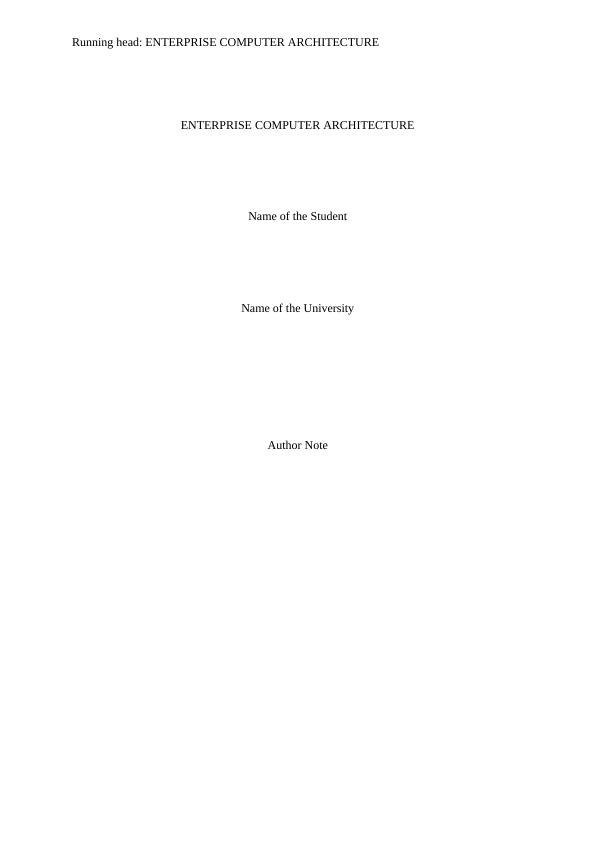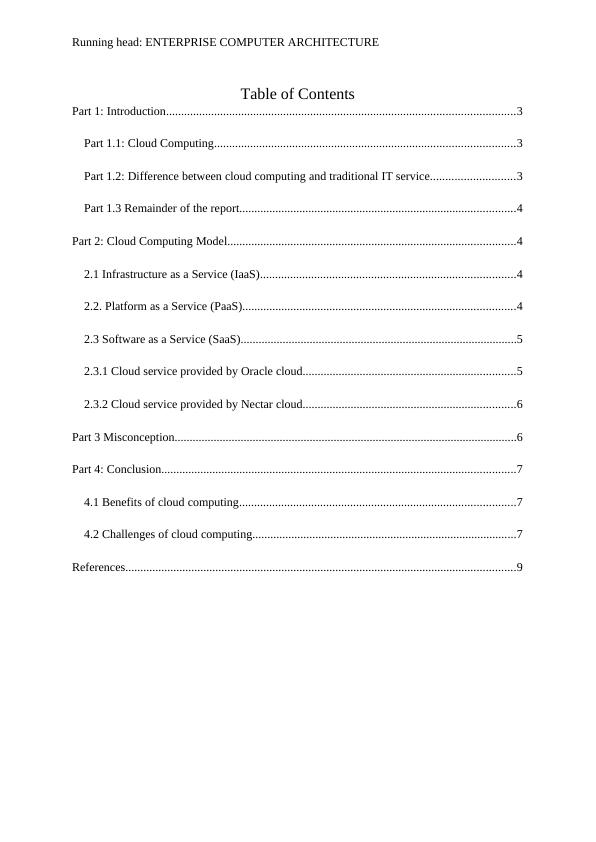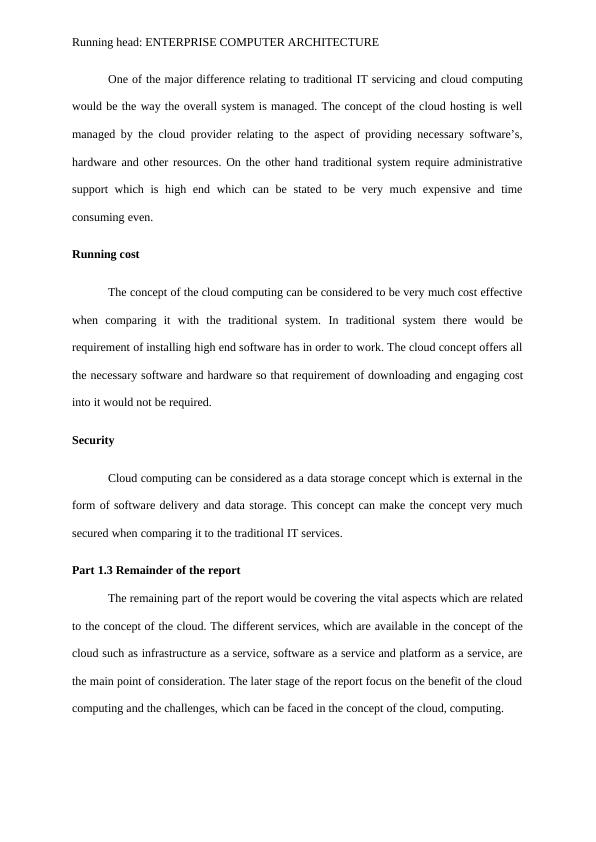Part 1: Introduction to Cloud Computing 3 Part 2: Cloud Computing Model 4 Part 1: Infrastructure as a Service (IaaS) 4 Part 2: Platform as a Service (PaaS) 4 Part 2: Cloud Computing Model 4 Part 2: Cl
Added on 2021-04-17
13 Pages3202 Words389 Views
Running head: ENTERPRISE COMPUTER ARCHITECTUREENTERPRISE COMPUTER ARCHITECTUREName of the StudentName of the UniversityAuthor Note

Running head: ENTERPRISE COMPUTER ARCHITECTURETable of ContentsPart 1: Introduction....................................................................................................................3Part 1.1: Cloud Computing....................................................................................................3Part 1.2: Difference between cloud computing and traditional IT service............................3Part 1.3 Remainder of the report............................................................................................4Part 2: Cloud Computing Model................................................................................................42.1 Infrastructure as a Service (IaaS).....................................................................................42.2. Platform as a Service (PaaS)...........................................................................................42.3 Software as a Service (SaaS)............................................................................................52.3.1 Cloud service provided by Oracle cloud.......................................................................52.3.2 Cloud service provided by Nectar cloud.......................................................................6Part 3 Misconception..................................................................................................................6Part 4: Conclusion......................................................................................................................74.1 Benefits of cloud computing............................................................................................74.2 Challenges of cloud computing........................................................................................7References..................................................................................................................................9

Running head: ENTERPRISE COMPUTER ARCHITECTUREPart 1: IntroductionPart 1.1: Cloud ComputingThe concept of cloud computing can be referred to as a service which is subscriptionbased where the user can obtain computer resources and storage device which is networked.One of the best example in this context is the email concept. The clients of the email such asYahoo, Hotmail, Gmail take direct care of the concept of housing of the all the software andhardware to support the email of the user. The only requirement is the internet connection ofthe user in order to access the features. The personal mail of the user is not housed in housebut are located at a specific location which is technically known as the cloud concept and thetechnology relating to it is known as the cloud computing. Part 1.2: Difference between cloud computing and traditional IT serviceThe main difference between the concept of cloud computing and the traditional ITservicing.Elasticity and ResilienceThe application and the information, which are hosted in the concept of the cloud, arevery much evenly distributed across the different servers, which work as a one server.Therefore, if one of the loud eventually breaks no data would be lost and the concept of thedowntime would be avoided. Traditional IT systems are not so much resilient and cannot guarantee the concept ofconsistency in the level related to the performance of the servers. The concept has lesscapacity and are very much liable to get susceptible to the concept of the downtime. Automation

Running head: ENTERPRISE COMPUTER ARCHITECTUREOne of the major difference relating to traditional IT servicing and cloud computingwould be the way the overall system is managed. The concept of the cloud hosting is wellmanaged by the cloud provider relating to the aspect of providing necessary software’s,hardware and other resources. On the other hand traditional system require administrativesupport which is high end which can be stated to be very much expensive and timeconsuming even. Running costThe concept of the cloud computing can be considered to be very much cost effectivewhen comparing it with the traditional system. In traditional system there would berequirement of installing high end software has in order to work. The cloud concept offers allthe necessary software and hardware so that requirement of downloading and engaging costinto it would not be required. SecurityCloud computing can be considered as a data storage concept which is external in theform of software delivery and data storage. This concept can make the concept very muchsecured when comparing it to the traditional IT services. Part 1.3 Remainder of the reportThe remaining part of the report would be covering the vital aspects which are relatedto the concept of the cloud. The different services, which are available in the concept of thecloud such as infrastructure as a service, software as a service and platform as a service, arethe main point of consideration. The later stage of the report focus on the benefit of the cloudcomputing and the challenges, which can be faced in the concept of the cloud, computing.

End of preview
Want to access all the pages? Upload your documents or become a member.
Related Documents
Cloud Computing: Types, Advantages and Disadvantageslg...
|8
|1314
|485
Cloud Computing: Benefits and Issues for GTGOVlg...
|12
|1331
|96
Benefits and Limitations of Cloud Computing PDFlg...
|14
|2989
|144
Cloud Computing: Models, Misconceptions and Services by Oracle and Nectar Cloudlg...
|13
|3388
|278
Cloud Computing: Models, Services, Misconceptions and Exampleslg...
|14
|3734
|270
Advantages and Disadvantages of Cloud Computinglg...
|6
|882
|62